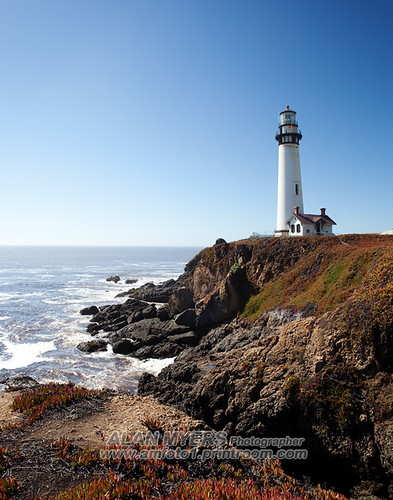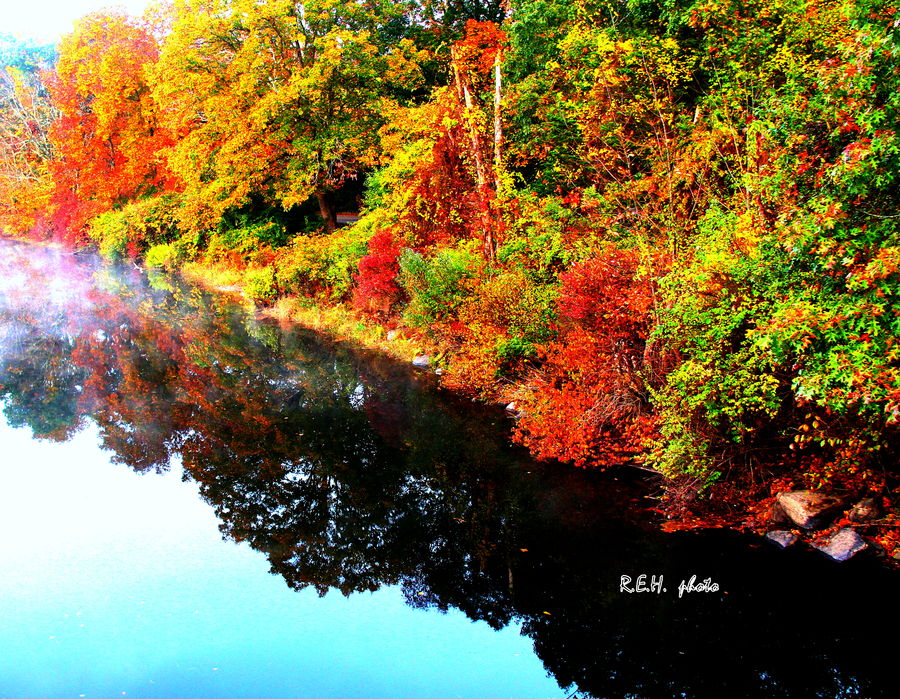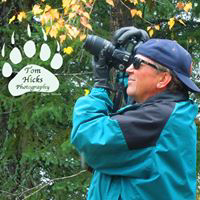Filters used for Fall Colors?
Sep 23, 2021 09:14:35 #
rgrenaderphoto wrote:
The good thing about fall colors is that no filters are necessary to capture the display that nature supplies. Sometimes I use a clear protective filter. But thats all. These are "filter free"A CPL to cut down glare on the leaves, an ND in case you're shooting into the sun and need toNknock down a potentially exposed sky, and a U/L to protect your lens.
Sep 23, 2021 09:27:25 #
Newer cameras have 'filters' built into them.
Mine has a setting called...'autumn leaves'...it pushes reds and yellows.
No need for filters at all.
Mine has a setting called...'autumn leaves'...it pushes reds and yellows.
No need for filters at all.
Sep 23, 2021 09:30:10 #
Sep 23, 2021 10:11:35 #
BadPhoto wrote:
Polarizing filters are useful to cut reflected lig... (show quote)
I have to disagree. It’s easier to see with the EVF because it adjusts the exposure so it’s not darkened like with an OVF.
Sep 23, 2021 10:41:47 #
Sep 23, 2021 10:54:45 #
amfoto1
Loc: San Jose, Calif. USA
bigguytf wrote:
Will be taking some Fall Color pics over the next Month. Does taking these pics require any special filters?
Does bright sun, clear skies or cloudy skies affect the type of filter used.
I normally tries to keep filters simple, I have UV, Polarized, and a neutral density filter currently in my bag.
Thanks in advance for any input
Does bright sun, clear skies or cloudy skies affect the type of filter used.
I normally tries to keep filters simple, I have UV, Polarized, and a neutral density filter currently in my bag.
Thanks in advance for any input
By far the most important filter for fall colors (and other times of year) is a polarizer.
This is because foliage tends to be reflective. It's especially noticeable when skies are overcast. The polarizer will reduce the reflection and really help saturate colors.
Especially if you shoot RAW you can adjust white balance and, if you wish, increase color saturation quite easily in post-processing (beware of overdoing it).
But you can't tweak what isn't there to work with... and that's where the polarizing filter is most helpful. If you have skies in the image a polarizer also will deepen the blues and make white cumulus clouds really "pop".
A couple things to watch out for with polarizers are if the image includes reflections off water that you want to capture, you may need to dial back the filter or not use it at all. Also, if there is a rainbow in the shot a polarizer will make it disappear. And, if shooting directly into the sun... such as a sunrise or sunset... beware of using any filter, but especially of using multi layer filters like polarizers. When the sun or any other strong light source is within the image or very close to it's edge, filters can increase issues such as veiling flare and ghost flare artifacts. Linda From Maine's shot of the sun through a tree is an example where I'd remove any and all filters from my lens.
Shooting digital, I never use graduated neutral density filters any more (I used them with film, years ago). With digital images there are simple ways to accomplish the same effects far better than was ever possible with the filters.
One or two different strengths of standard neutral density filters might be helpful if you want a longer exposure than is possible using only the camera's ISO setting and a smaller lens aperture. For example, you may wish to cause moving water to have that "smooth and foamy" look. Be cautious of other moving objects becoming blurred, though... such as if a breeze is causing the foliage to move.
Below is an example I shot using a C-Pol. In this case the foliage was in shade and the day was overcast. That made for nice, soft lighting without heavy shadows. But notice the reflections on the leaves, even though I used the C-Pol to it's maximum. Without the filter the colors would have been much more muted.

Finally, yes a polarizing filter on a wide angle lens can make for uneven effects that can be most noticeable in large swaths of clear blue sky. This really depends upon the orientation of the light source in relation to the image. Polarizers have their strongest effect 90 degrees from the light source. The filter's effect gradually tapers off to nothing at 180 degrees or 0 degrees. The lighthouse image below was shot with a 20mm lens, a polarizing filter and the late afternoon sun located just to the left low on the horizon. Because of the clear blue sky, the uneven effect is obvious (but not necessarily a bad thing) in this image...

Here's another shot where the filter's uneven effect is largely hidden in the cloud detail...

The midday sun was directly above and somewhat behind me for this fishing fleet shot below, so the same lens with the same filter made for a very even effect in the sky (in fact I had to dial back the filter a bit to keep from losing too much of the reflections)...

Finally, for this direct sunset shot with the same lens I deliberately didn't use a C-Pol or any other filter to avoid flare issues. I also didn't want to reduce the reflections off the water, wet rocks and sand, which I felt were important to the image. Not that the filter would have had much effect anyway, since it's close to 0 degrees...

Sep 23, 2021 11:20:34 #
bigguytf wrote:
Will be taking some Fall Color pics over the next Month. Does taking these pics require any special filters?
Does bright sun, clear skies or cloudy skies affect the type of filter used.
I normally tries to keep filters simple, I have UV, Polarized, and a neutral density filter currently in my bag.
Thanks in advance for any input
Does bright sun, clear skies or cloudy skies affect the type of filter used.
I normally tries to keep filters simple, I have UV, Polarized, and a neutral density filter currently in my bag.
Thanks in advance for any input
No special filters are *required*. However:
UV filters are only helpful above about 6000 feet above sea level. On the East Coast of the USA, only Mount Mitchell in NC is that high... and I've never needed a UV filter on my digital camera there. Below that, there's not enough UV to affect digital camera sensors. Film, yes, digital, no. (Experiment... camera sensor technologies do vary). If you're trying to protect a lens, get a clear glass protector made for that purpose.
When you use them to reduce reflections from water and foliage, circular polarizers are needed for digital photography, as opposed to the old kind we used with film. A CPL will also darken skies at right angles to the sun. It *may* help saturate colorful foliage in full sun at certain angles.
ND filters are primarily useful for reducing light intensity — to use longer shutter speeds or wider apertures, or both. ND filters are used for the "fake felt painting silky water" effect that has become a cliché at "art" shows. Cinematographers use them in bright sun to maintain 1/48 second (180° shutter angle) speed for 24.000 fps video, while still using a reasonably wide aperture for shallow depth of field. Still photographers use them to isolate subjects against the background with a wide aperture. I keep ND8, ND64, and ND1000 filters in my bag...
Graduated ND filters are useful for darkening bright skies without affecting foreground exposures. "Star" filters are another cliché category, turning bright light sources and specular reflections into multi-point star reflections. Soft focus filters are useful for creating dream-like images. Beyond those, there are plenty of other cheesy filter attachments from the 1960s that create cliché psychedelic poster effects. Way beyond those, there is Photoshop...
MOST special effects we once did with color filters may now be achieved in post-production of raw files. Good post-production software is well-equipped with a wide array of tools and filters for nearly infinite control over effects that used to be monotonic.
My personal preference for fall foliage is to capture the color when leaves are wet with rain or dew, early in the morning or in fog. Nature is my favorite filter.
Sep 23, 2021 12:17:20 #
BadPhoto wrote:
Quick hint: if you are shooting mirrorless, then look through the filter and decide it's orientation before putting it on the camera. It's too hard to see what the filter is doing with an EVF.
Quick hint: if you are shooting mirrorless, then look through the filter and decide it's orientation before putting it on the camera. It's too hard to see what the filter is doing with an EVF.
Huh??
One advantage of the EVF is you can see exactly what is going to be recorded, including the effects of filters.
I think perhaps you need to revisit your EVF settings.
There are typically two EVF modes: one mode will maintain constant brightness in the EVF. The other mode will change EVF brightness based on the brightness of the scene.
Sep 23, 2021 12:35:32 #
Surprisingly the enhancing filter does work. Although almost anything can be achieved in raw
Sep 23, 2021 13:26:38 #
Sep 23, 2021 13:38:12 #
CPL and all filters are LENS ATTACHMENTS, not permanent parts of the lens. I know that sounds silly but you can screw them on, screw them off and if you don't know how to use them effectively, you can screw up your images.
May photographic accessories have advantages and disadvantages so you need to know when and how to apply them and when not to apply them and how to workaround any shortcomings and maximize their usage.
Polarization is a very effective method of controlling, eliminating, or modifying unwanted reelection and glare without undesirable colour shifts. All of its effects can not be easily or practically replicated in post-processing if at all. I can increase colour saturation by negating the glare off of certain surfaces such as foliage under certain light conditions.
Using a CPL filter on a wide-angle lens for the purpose of intensifying skyscapes can be problematic because a particular angle to the sun is required to achieve the effect. Since a wide-angle lens may include more than the ideal angle in the frame, the effect may not be uniform from edge to edge.
You do not need to be well versed in physics or optics to use a CPL filter effectively, especially in digital photography. The exact effect will appear in the viewfinder as you rotate the filter. You do not need to measure the angle for the light source with any instrumentation like a sextant. If the CPL filter has no effect on the sky, you are at the wrong angle- when you are at the correct angle, the result will be dramatic. A CPL filter is not a "haze" filter or a "cloud filter" (such as a yellow or red filter used in black and white photography) and does not work like inferred photograhy. It will not produce blue sky and puffy clouds on overcast days.
If you are shooting landscapes or other static subjects, you can shoot with and without the CPL filter and rotate the filter for various degrees of its effect. This is how you learn to use your filter appropriately and previsualize the effect you want.
Do not purchase a cheap filter, especially a polarizer. A poorly crafted filter can introduce colour shifts and mechanically speaking, can cross-thread and jam. Since you need to rotate the filter to operate it, you want smooth actions and a sturdy metal rim. All filters add additional glass surfaces to the optical path. Good lens shading is important to preclude the additional potential for flare.
May photographic accessories have advantages and disadvantages so you need to know when and how to apply them and when not to apply them and how to workaround any shortcomings and maximize their usage.
Polarization is a very effective method of controlling, eliminating, or modifying unwanted reelection and glare without undesirable colour shifts. All of its effects can not be easily or practically replicated in post-processing if at all. I can increase colour saturation by negating the glare off of certain surfaces such as foliage under certain light conditions.
Using a CPL filter on a wide-angle lens for the purpose of intensifying skyscapes can be problematic because a particular angle to the sun is required to achieve the effect. Since a wide-angle lens may include more than the ideal angle in the frame, the effect may not be uniform from edge to edge.
You do not need to be well versed in physics or optics to use a CPL filter effectively, especially in digital photography. The exact effect will appear in the viewfinder as you rotate the filter. You do not need to measure the angle for the light source with any instrumentation like a sextant. If the CPL filter has no effect on the sky, you are at the wrong angle- when you are at the correct angle, the result will be dramatic. A CPL filter is not a "haze" filter or a "cloud filter" (such as a yellow or red filter used in black and white photography) and does not work like inferred photograhy. It will not produce blue sky and puffy clouds on overcast days.
If you are shooting landscapes or other static subjects, you can shoot with and without the CPL filter and rotate the filter for various degrees of its effect. This is how you learn to use your filter appropriately and previsualize the effect you want.
Do not purchase a cheap filter, especially a polarizer. A poorly crafted filter can introduce colour shifts and mechanically speaking, can cross-thread and jam. Since you need to rotate the filter to operate it, you want smooth actions and a sturdy metal rim. All filters add additional glass surfaces to the optical path. Good lens shading is important to preclude the additional potential for flare.
Sep 23, 2021 14:01:42 #
Thanks to everyone for their posts! I learned a great deal about filters and their uses - when to use, when not to use,etc.. I will use this in my fall photography and hopefully will enhance my efforts to capture the beauty and majesty of fall in Montana.🐾
Sep 23, 2021 14:26:13 #
I stopped using filter for color when i went digital. You can accomplish much of the same effects in post processing. I even hesitate to use polarizers or NDs. I just don't want the extra glass.
Sep 23, 2021 15:24:03 #
Gene51 wrote:
Shooting raw will allow you to record as much of t... (show quote)
My apologies - I wrote UV filter but clearly was thinking Circular Polarizer (CPL). Please don't hold it against me

Sep 23, 2021 15:28:09 #
If you want to reply, then register here. Registration is free and your account is created instantly, so you can post right away.
















